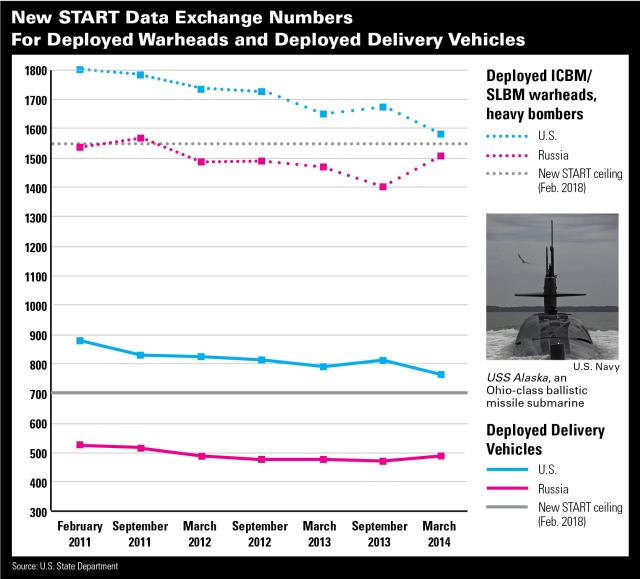By Greg Thielmann
The latest data on strategic weapons exchanged between Russia and the United States under terms of the 2010 New Strategic Arms Reduction Treaty (New START) shows movement by both countries toward the three key limits of the treaty. In spite of bilateral tensions over events in Ukraine, these data from the beginning of March and the fact that subsequent on-site inspections continue suggest that treaty implementation is still on track.
A quick glance at the deployed warhead trend line could raise concerns in the context of the recent sharp deterioration in the U.S.-Russian political relationship. The large advantage in U.S. warheads of nearly 300 from last September has been reduced to less than 75, and all three counts of U.S. systems are down, whereas two of the three metrics of Russian forces are up.
However, such fluctuations reflect routinely scheduled events like refitting and refueling nuclear submarines, which can create spikes in the operationally deployed warhead totals. The more important measure is the long-term trends.
Russia Winning the Race Downward
The overall downward trend to date on the Russian side of the equation is likely to continue through this decade, independent of perturbations in Moscow's relations with the West. The Cold War backbone of Russia's Strategic Rocket Forces has been its ageing inventory of liquid-fuel, heavy ICBMs (each with ten warheads) and many more smaller solid-fuel, road-mobile ICBMs (each with a single warhead). These weapons are now being slowly replaced by a lesser number of new solid-fuel, road-mobile ICBMs (each with a few warheads).
Russia's submarine-launched nuclear weapons are a much less important leg of the strategic triad than are their U.S. counterparts. But Moscow is replacing most of its existing ballistic missile submarines with eight new-design SSBNs, armed with a new solid-fuel SLBM (carrying 2-3 more warheads each than carried by the older liquid-fuel missiles). However, this SLBM, the "Bulava," has been plagued with technical problems. The deployment schedule has accordingly slipped and could slip further.
Only gradual numerical changes are expected in Long-Range Aviation, the least important leg of Russia's nuclear triad.
Based on current trends and projections, it is reasonable to assume that Russia's deployed warhead totals will decline by 200-300 before the new, heavily-MIRVed ICBMs under development can be deployed in sizeable numbers toward the beginning of the next decade.
U.S. Taking its Time
Meanwhile, the pace of U.S. implementation of New START reductions is modest in the extreme. Current administration plans do not call for the United States to meet the 1550/800/700 central limits of New START for another four years – until the February 1, 2018 deadline established under the treaty.
According to an April 8 summary of the Defense Department's "Nuclear Force Structure" plans, the submarine forces will continue to comprise the largest and most survivable leg of the nuclear triad and the number of deployed heavy bombers will be reduced by a third.
However, the plan still calls for the deployment of 400 single-warhead ICBMs in silos throughout the upper plains states. The force structure decisions are very cautious, especially the choice to preserve 50 empty ICBM silos in "warm" condition, ready to receive back their "non-deployed" missiles if needed.
Such an approach is uncessary given the fact that there is already a huge "hedge" as a result of the large U.S. warhead upload potential for both ICBMs and SLBMs.
A Dearth of Determination to Follow Through
In spite of President Obama's vision of a future world without nuclear weapons, which he articulated in his April 2009 Prague speech, there are no bold second acts in sight to follow his first-term achievement of negotiating and ratifying New START.
Although Obama has persisted in encouraging international efforts to secure nuclear materials through the Nuclear Security Summit process he launched in 2009, hyper-partisanship at home and hyper-nationalism in Russia have discouraged him from taking other actions in his second term commensurate with the nuclear weapons goals laid out in his Berlin speech of June 2013.
If President Obama had a willing partner in Moscow, it seems likely that he would be vigorously pursuing the further one-third reduction in strategic forces that he and his national security team have already determined is sufficient for U.S. nuclear deterrence.
But some sensible steps to reduce the role and burden of nuclear weapons are still available, even without Moscow's active engagement. For example, he could, as commander-and-chief, at least accelerate U.S. nuclear weapons reductions down to the New START limits already approved by the Senate – and preferably further, to the lower levels now deployed by Russia.
Lessons of Ukraine
The Crimean crisis should provide an opportunity for sober reflection on what the world would be confronting if the 1,900 nuclear warheads located in Ukraine at the end of the Cold War had remained there. Moreover, the political dynamics of the tense standoff between Russia and the West over Ukraine would not be fundamentally affected if the United States had 500 more or 500 less operationally deployed strategic warheads than it has today.
Unfortunately, the pre-nuclear notions of power and politics die hard. Until the disutility of nuclear weapons at the margins of the large U.S. and Russian arsenals is fully appreciated, rational steps toward a safer world will be small and halting.

